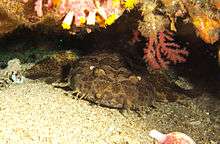Wobbegong
Wobbegong is the common name given to the 12 species of carpet sharks in the family Orectolobidae. They are found in shallow temperate and tropical waters of the western Pacific Ocean and eastern Indian Ocean, chiefly around Australia and Indonesia, although one species (the Japanese wobbegong, Orectolobus japonicus) occurs as far north as Japan. The word wobbegong is believed to come from an Australian Aboriginal language, meaning "shaggy beard", referring to the growths around the mouth of the shark of the western Pacific.
| Wobbegongs | |
|---|---|
 | |
| Spotted wobbegong, Orectolobus maculatus, showing the camouflage pattern and skin flaps typical of wobbegongs. | |
| Scientific classification | |
| Kingdom: | Animalia |
| Phylum: | Chordata |
| Class: | Chondrichthyes |
| Order: | Orectolobiformes |
| Family: | Orectolobidae T. N. Gill, 1896 |
| Genera | |
Description
Wobbegongs are bottom-dwelling sharks, spending much of their time resting on the sea floor. Most species have a maximum length of 1.25 m (4.1 ft) or less, but the largest, the spotted wobbegong, Orectolobus maculatus, and banded wobbegong, O. halei, reach about 3 m (9.8 ft) in length.
Wobbegongs are well camouflaged with a symmetrical pattern of bold markings which resembles a carpet. Because of this striking pattern, wobbegongs and their close relatives are often referred to as carpet sharks. The camouflage is improved by the presence of small weed-like whisker lobes[1] surrounding the wobbegong's jaw, which help to camouflage it and act as sensory barbs. Wobbegongs make use of their camouflage to hide among rocks and catch smaller fish which swim too close, typical of ambush predators.
Interaction with humans
Wobbegongs are generally not considered dangerous to humans,[2] but have attacked swimmers, snorkellers and SCUBA divers who inadvertently come close to them.[2] The Australian Shark Attack File contains more than 50 records of unprovoked attacks by wobbegongs,[2] and the International Shark Attack File 28 records;[3] none of them fatal. Wobbegongs have also bitten surfers.[4] Wobbegongs are very flexible and can easily bite a hand holding onto their tail.[5] They have many small but sharp teeth and their bite can be severe, even through a wetsuit; having once bitten, they have been known to hang on and can be very difficult to remove.[6]
There are many more instances of unprovoked attacks on wobbegongs: in Australia, the flesh of wobbegongs and other shark species is called flake and it is often the "fish" component of fish and chips. Wobbegong skin is also used to make leather.[7]
Captivity
Although most wobbegong species are unsuitable for home aquaria due to their large adult size, this has not stopped some of the larger species from being sold in the aquarium trade.[8] Small wobbegong species, such as the tasselled wobbegong and Ward's wobbegong, are "ideal" sharks for home aquarists to keep because they are an appropriate size and are lethargic, enabling them to be accommodated within the limited space of home aquaria, although they will consume tankmates, even quite large ones.[8] Some aquarists, by contrast, see the lack of activity to be a drawback to keeping wobbegongs and prefer more active sharks.[8] Wobbegongs are largely nocturnal and, due to their slow metabolism, do not have to be fed as often as other sharks. Most do well on two feedings weekly. Underfed wobbegongs can be recognised by visibly atrophied dorsal musculature.[8]
Genera and species
The 12 living species of wobbegong, in three genera, are:[9]
- Genus Eucrossorhinus Regan, 1908
- Eucrossorhinus dasypogon (Bleeker, 1867) (tasselled wobbegong)
- †Eucrossorhinus microcuspidatus Case 1978
- Genus Orectolobus Bonaparte, 1834
- Orectolobus floridus Last & Chidlow, 2008 (floral banded wobbegong)
- Orectolobus halei Whitley, 1940.[10] (Gulf wobbegong or banded wobbegong)
- Orectolobus hutchinsi Last, Chidlow & Compagno, 2006.[11] (western wobbegong)
- Orectolobus japonicus Regan, 1906 (Japanese wobbegong)
- Orectolobus leptolineatus Last, Pogonoski & W. T. White, 2010 (Indonesian wobbegong)
- Orectolobus maculatus (Bonnaterre, 1788) (spotted wobbegong)
- Orectolobus ornatus (De Vis, 1883) (ornate wobbegong)
- Orectolobus parvimaculatus Last & Chidlow, 2008 (dwarf spotted wobbegong)
- Orectolobus reticulatus Last, Pogonoski & W. T. White, 2008 (network wobbegong)
- Orectolobus wardi Whitley, 1939 (northern wobbegong)
- Genus Sutorectus Whitley, 1939
- Sutorectus tentaculatus (W. K. H. Peters, 1864) (cobbler wobbegong)
Fossil genera include:
- Eometlaouia Noubhani & Cappetta, 2002
References
- "Wobbegongs - five species encountered in Queensland". Queensland Primary Industries and Fisheries. 2009-03-02. Archived from the original on 1 Aug 2012. Retrieved 2009-06-14.
- John G. West (2011). "Changing patterns of shark attacks in Australian waters" (PDF). Marine and Freshwater Research. pp. 744–754.
- "Species Implicated in Attacks - International Shark Attack File". Retrieved 2018-04-06.
- "Shark attack victim Kirra-Bella Olsson, 13, 'laughed' after ankle and calf were mauled by a wobbegong". The Daily Telegraph. 2014-10-18. Retrieved 2014-10-19.
- Kuiter, Rudie (1999). Guide to Sea Fishes of Australia (amended ed.). New Holland Publishers (Aust.) Pty Ltd. p. 12. ISBN 1-86436-091-7.
- "Shark sinks its teeth in for the long haul". The Sydney Morning Herald. 2004-02-12. Retrieved 2006-06-14.
- Debra A. Rose; International Traffic Network (1 December 1996). An overview of world trade in sharks and other cartilaginous fishes. TRAFFIC International. ISBN 978-1-85850-114-7.
- Michael, Scott W. (March 2004). "Sharks at Home". Aquarium Fish Magazine. pp. 20–29.
- Froese, Rainer, and Daniel Pauly, eds. (2009). "Orectolobidae" in FishBase. January 2009 version.
- Huveneers (2006). "Redescription of two species of wobbegongs (Chondrichthyes: Orectolobidae) with elevation of Orectolobus halei Whitley 1940 to species level" (PDF). Zootaxa. 1284: 29–51.
- Last, Chidlow & Compagno (2006). "A new wobbegong shark, Orectolobus hutchinsi n. sp. (Orectolobiformes: Orectolobidae) from southwestern Australia" (PDF). Zootaxa. 1239: 35–48.
External links
- Froese, Rainer, and Daniel Pauly, eds. (2017). "Orectolobidae" in FishBase. April 2017 version.
- "Spotted Wobbegong, Orectolobus maculatus (Bonnaterre, 1788)". Australian Museum.
